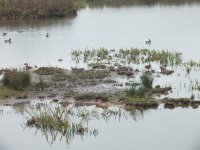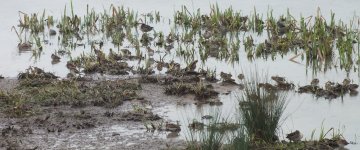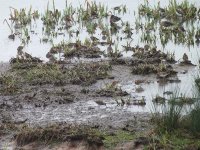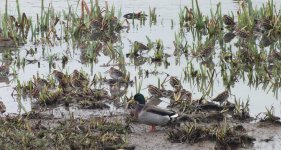MOORS:
At last a normal November day. Being cold and wet, with a definite winters feel, due to the cold easterly wind. Some birds reflected this, but no more so than the massive increase in thrush numbers. The common snipe too were well represented and snipe island was overwhelmed by them. Although there were no jacks amongst them, there were at least 3 on the 'promontory'. But the one group usually associated with winter namely the wildfowl, were still not arriving. A year tick for me was nuthatch, with 2 performing in the pear tree by the east gate. Chaffinch and goldcrest appear to have increased as a result of the recent easterlies.
Species counts MOORS:
GCG, Little grebe 6, cormorant 12, greylag 1, shoveler 44, teal 45, tufted 12, coot 220+, water rail very vocal along whole of east side and swampy bottom. Common Snipe 116 (101 were on snipe island during the rail), Jack snipe 3, lapwing 55, curlew, BHG 200, very few large gulls, Kingfisher, green woodp, great sp woodp, Nuthatch 2, jay, mistle thrush fieldfare 80+, redwing 550, song thrush 3 by east gate, blackbird no count but at least 10 in a short stretch of the east track, grey wag, goldfinch 42, chaffinch 6, redpoll, goldcrest 3, cettis w 2, meadow pipit,
The Flashes were much quieter, but then again they always are at this time of year. Although things were picking up as the day progressed, unfortunately I couldn't stay until dark. A male peregrine flew through with a futile attempt to catch something, but it did cause mayhem for a couple of minutes. Andy P found a couple of Jack snipe along the southern shore, they later disappeared into the patch of stunted reeds. The now wet 'meadow', was providing food for lapwing , curlew, coot, moorhen and a crow which had caught a 'sick' BHG and was slowly dispatching it, while the bird was still alive. A large thrush of redwing landed in the eastern orchard, while a large group devoured the berries along the western hedgerow.
Species count FLASHES
Little grebe - 3rd Flash, shoveler 11, teal 18 (also 5 on hen pool), mallard 20, coot 11 min, water rail - hen pool, moorhen 40+, snipe 4, jack snipe 2, lapwing 112, curlew 13, BHG 120, LBBG, Buzzard, peregrine, redwing 300+, fieldfare 20, song thrush 2, Cettis w singing from 3rd Flash SE corner, goldcrest, chaffinch few,








